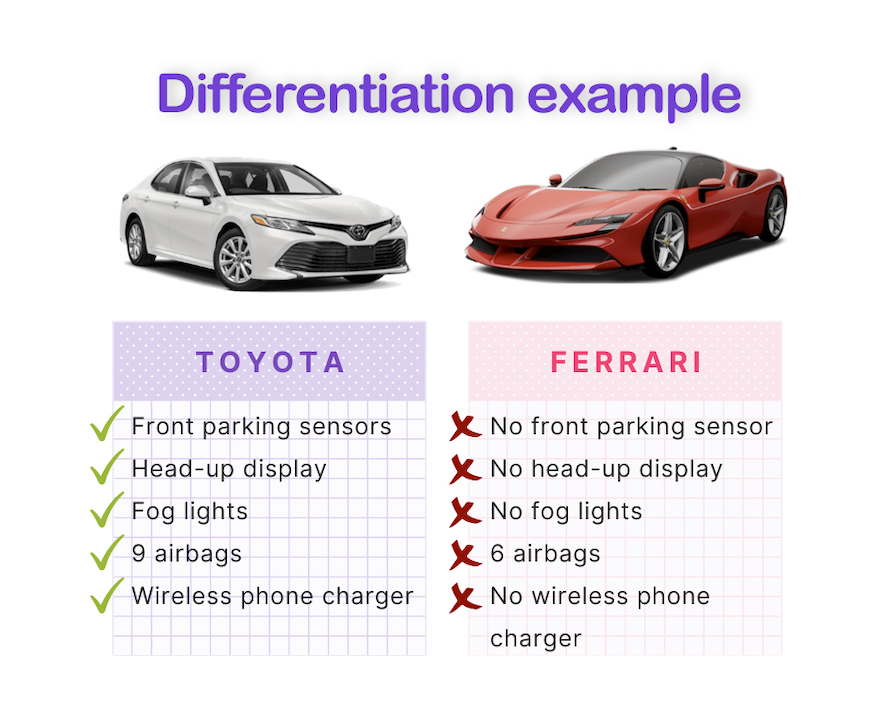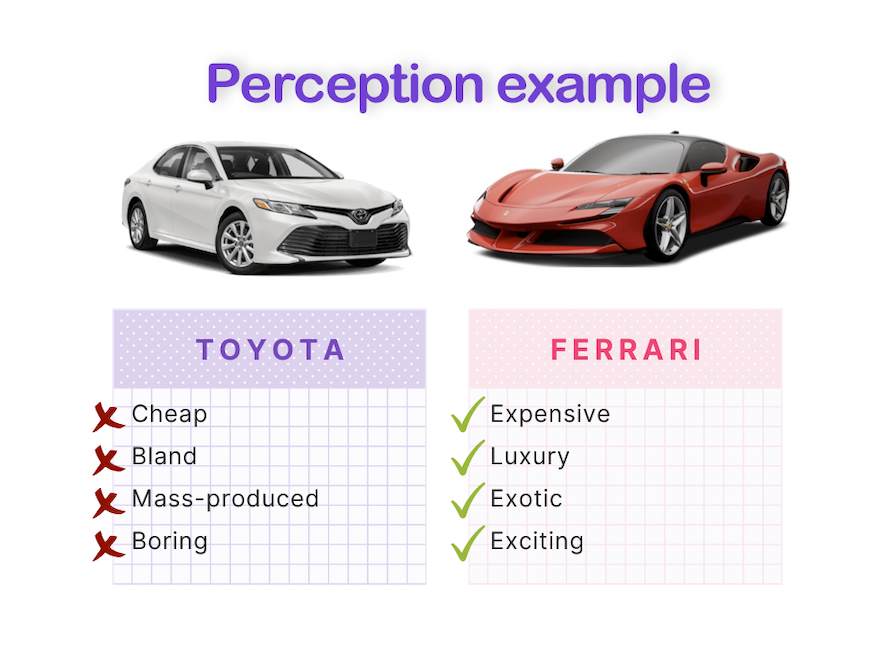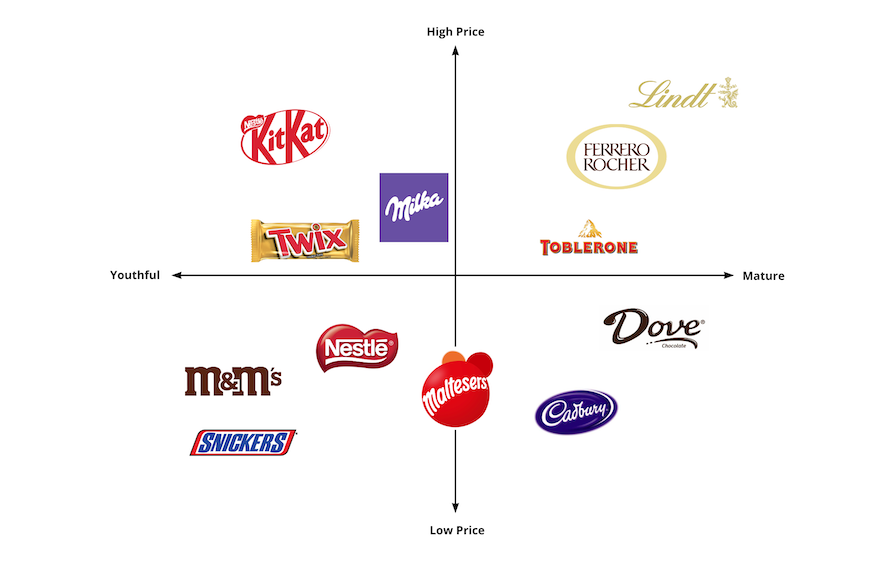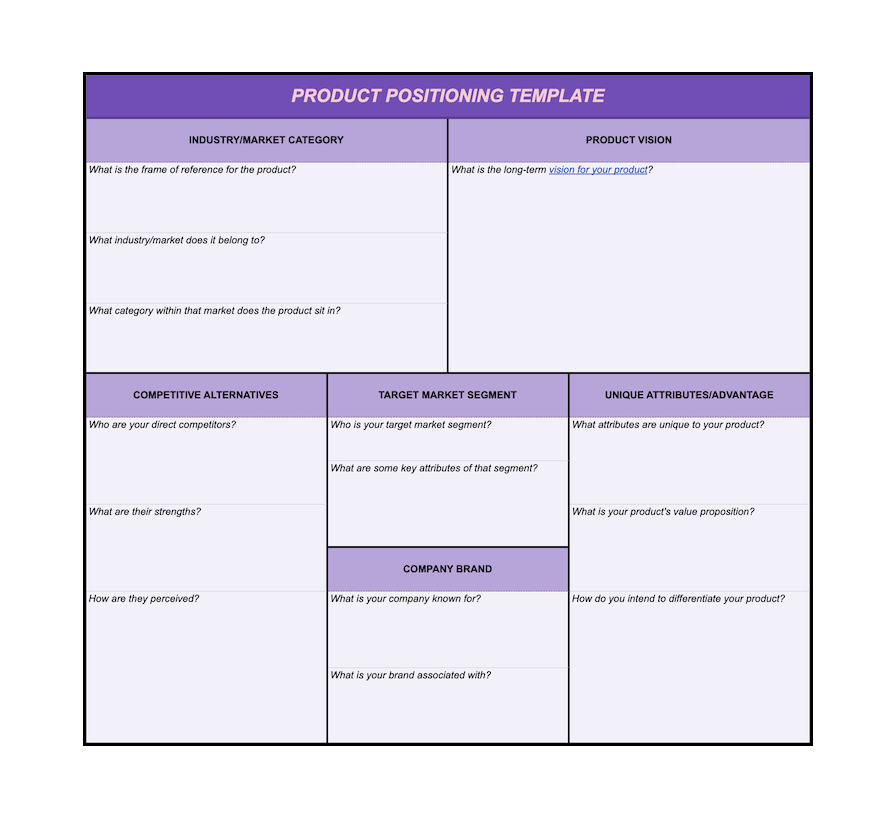Editor’s note: This article was reviewed on 16 August 2024 by Daniel Schwarz and updated to include information such as how product positioning differs from brand positioning, what a product positioning statement is, specific product positioning strategies such as price-based positioning and how they compare to other strategies like quality-based positioning, and more.

The right positioning can transform a struggling product into one that flies off the shelves. That’s because positioning is about perception; calibrating the right perception of your product is paramount to conveying the value it brings over its competitors.
Product positioning is the act of defining where your product fits in the market relative to its competitors as perceived by your customers.
Let’s break down this definition of product positioning:
Product positioning is not differentiation. A product’s positioning must work with its differentiation, but they are not the same thing.
Here’s simplest way to describe the distinction between product positioning and differentiation:
In other words, a product’s differentiation is (more often than not) the tangible difference. For example, does your product offer better features than your competitors?
Let’s say you’re comparing the features available in a Toyota Camry versus a Ferrari:

As you can see, the Toyota is superior if you’re solely concerned about functionality and practicality.
Positioning, on the other hand, is perceptual. It has little to do with the actual features and functionality.
How is your product perceived? Is it seen as a luxury? High-end or budget? Is it seen as being of higher quality than your competitors? Or, is it perceived as fun and more innovative?
Let’s look again at the example of the Toyota and the Ferrari:

That’s product positioning — how your product is perceived by the market relative to your competitors.
Now that you’ve determined your product positioning, you can use it to differentiate your product. The two need to go hand-in-hand, but the crucial difference is that positioning is about perception, not physical differentiation.
Product positioning and brand positioning are two marketing strategies that can help your company differentiate itself from its competitors in the eyes of your customers.
Product positioning can motivate your target customers to choose your products by framing the product’s qualities and benefits in a way that appeals to them specifically. This not only leads to more conversions, but also higher retention rates (i.e., less buyer’s remorse) as long as the product messaging meets reality.
Brand positioning is very similar and applies to your brand as a whole. The messaging should convey that your brand holds the same values as your target customers, as a result making them think highly and feel positively towards it, while also conveying how it stands out from its competitors.
So while you obviously want to convey how good your products are and how good your brand is, product positioning and brand positioning both go a step further by helping you to convey suitability — that is, how good your product is for your customers specifically, especially in the ways that rival products and brands aren’t.
Good products can be owned by bad brands and vice-versa, therefore crafting your product positioning and brand positioning are two different ventures, although you’ll likely do so at the same time, using the same research and research participants for both.
Sometimes, quality isn’t as important as price (and vice versa). This is why Scoot and Singapore Airlines are two separate brands, despite being the same company. I probably don’t need to tell you which one markets itself as low-cost and which one markets its ranking as a 5-star airline.
In cases like this, where messaging is used to position multiple brands of the same company, each brand’s negative qualities (in the eyes of customers) are separated so as not to be associated with the other brands.
Quality-based positioning is more associated with brand positioning, whereas price-based positioning is more associated with product positioning. However, the concepts are closely related in many ways; for example, high quality is often associated with high price, which is why brands tend to target a specific quality.
There are also many other types of positioning, which provides more ways to craft a message that appeals to your target audience. For example, other forms of product positioning include:
Product positioning is important because, while physical differentiation is good, decisions are often made based on how a product is perceived.
For example, purchasing a luxury car or handbag is emotional — not because of how it looks or its design or size, but because of how it’s perceived.
After all, nobody decides against buying a Ferrari because it doesn’t have a heads-up display or wireless charging ; they buy it (at exorbitant price points) because it’s a Ferrari!
The product and brand are positioned such that they carry a certain perception, one that is highly desirable regardless of actual physical features. Leveraging the power of perception can reduce the need for physical differentiation and enable you to demand a higher price point.
The following elements should influence your product positioning strategy.
The first and most important step to defining your product positioning strategy is understanding your market.
While there is no single way to conduct market analysis, some core questions you might explore include:
Product positioning is all about how your products are perceived in relation to their direct competitors. Therefore, it’s paramount to have a good understanding of your competitors.
Of course, you want to build a deep understanding of your competitors, their strengths and weaknesses, and differentiation. Equally importantly, you want to analyze your competitors’ strategy and how they are positioned in the market.
Building a holistic picture of the competitive landscape can help you identify positions in the market that may be saturated or underserved. A great tool for this is perceptual mapping (more on that later).
Defining your target market segment is core to product positioning. For example, let’s say you want to position your product as a luxury item, but your core target market are teenagers. Needless to say, few of them are likely to be able to afford your product.
Another example would be a B2B product aimed at early-stage startups versus one that targets large enterprises. The latter would be more focused on being perceived as safe, secure, and capable. The former would be more concerned with positioning itself as youthful and fun.
Your product’s positioning will be heavily influenced by your company brand and its current positioning.
For example, Apple positions itself as innovative and creative and seeks to target that market. For a long time, Apple leveraged this reputation to differentiate itself from other computer brands and capture a customer base of creative professionals, from musicians to artists and the like.
As such, Apple’s products also live and breathe this ethos: they are aesthetically pleasing, often colorful, and carry a design that is unlike any of their competitors.
Finally, your product vision and value proposition play a key role in product positioning. Understanding the key differentiator — your moat — is core to defining what makes your product unique in the market. An effective product position will hone in on this and amplify it.
A product positioning statement is a brief summary of a product’s distinctiveness, particularly in regards to the ways that customers would think of it as not only a good product but a good product for them. For example, if customers don’t care about the price of your product, then you wouldn’t make its low price the focus of the product’s messaging.
The goal of a product positioning statement is to clarify, for yourself and others, how to market to customers in terms of product messaging.
To write a good product positioning statement, you first need to be clear about the types of product positioning on which you’re basing your product messaging. For example, you could emphasize price, lifestyle, benefits, characteristics, or anything else that’s relevant.
Product positioning statements are made up of just a few sentences, so as long as they’re clear, you shouldn’t have any issues writing a good one. If you’re having trouble getting started though, write about the product as if you’re the customer, then simply change the language from a first-person narrative to a third-person narrative.
For example, a customer might say, “I want a [cheap] product that helps me to be my [x] self. I want it to do [x] and [x], and it has to have an [x] feature”. To turn this into a product positioning statement, you’d instead say, “Our customer wants…”.
However, you first need to determine what your position is among your competitors. To do that, you’ll need to create what’s called a perceptual map.
One of my go-to tools for understanding the market to find the ideal product positioning is a perceptual map.
Perceptual mapping, also known as market mapping, is a diagrammatic technique used to visualize the relative positioning of competitive products. Typically in the form of a 2×2 matrix, perceptual maps seek to map out direct competitors’ positioning relative to each other.
Perceptual maps can help you identify gaps in the market, crowded positioning, and when it may be time to reposition:

The axis on a perceptual map will vary depending on your market, products, and customers.
For example, you might map your products based on whether they are perceived as:
There’s no perfect science to creating a perceptual map. However, a perceptual map should be informed by research — namely, competitive analysis and customer research. Using this data, you will need to determine what attributes are important for your customers and how they perceive products in the market.
If you wish, you can also validate your perceptual map through perception-based questions as part of customer interviews.
In her book Obviously Awesome, April Dunford shares a personal story about the impact that the right positioning can have.
Dunford was working at a startup for a B2B database product. The company was struggling with sales. Although the product was superior to its competitors, the company found that customers often did not understand the value the product would bring over their current database solution.
Finally, Dunford’s team met with a prospect who argued that the product was not a database at all, but a business intelligence tool.
By repositioning the product as a business intelligence tool, the sales team saw immediate results. Once prospects stopped comparing the product to their existing database, they began to understand the problem the product was designed to solve and the value it could bring.
As you can see, positioning your product correctly can be a game changer. Apple, Nike, Lush, and Patagonia are all examples of companies that have done product positioning exceptionally well.
Let’s dive a bit deeper into each product positioning example.
Apple positions itself toward creative individuals by leveraging its reputation as an innovative company. It dominates this position in the market so well that you would be hard-pressed to find a designer who doesn’t use a MacBook.
This positioning translates into all aspects of the MacBook — from the applications aimed at creative industries, such as Final Cut Pro for video editing and Logic Pro for music, to its sleek design and unique features that challenge the norm.
Nike positions itself as a brand for elite athletes. Its tagline, “Just Do It,” models its positioning to push the limits of human performance. The products themselves emphasize quality and are frequently the go-to choice for athletes.
Lush is famous for their handmade, animal- and chemical-free products. They position themselves as a sustainable and ethical company that does not do animal testing and creates products that are not only good for you but for the environment too. This translates to Lush’s unique shop designs and the products themselves.
For example, you will find no packaging in a Lush store besides being wrapped in recycled paper at payment. The products themselves are imperfect and fragile, often sporting blemishes. This doesn’t detract from the product; in fact, it plays nicely into its positioning, promoting the fact that products are handmade and chemical-free.
Patagonia made headlines a couple of years ago when they launched an ad campaign Black Friday titled “don’t buy this jacket.” The campaign was a lobby against fast fashion and to promote sustainability.
Patagonia’s company mission leads the company to participate in activist and sustainability work. This translates into their products and services, from 100-percent recycled material to their free repairs service.
Unlike Netflix, which appears to focus very little on product positioning these days, Disney+ caters to a family lifestyle, targeting looking for value — i.e., who would be happy to pay more since it benefits the whole family. So, their product positioning covers lifestyle, price (value), and benefits.
Defining your product positioning strategy starts with critical consideration around the following elements:
Download a customizable Google Sheets version of the product positioning template below:

Keep in mind that not all of these questions need to be answered in a positioning statement though. You can treat them more like thought exercises to help you figure out how to think about and position your product accurately in a way that appeals to your target audience.
Product positioning can make or break your product. If your position is poor in the market, your product will sink.
Remember that to obtain the right positioning, you need to have a good understanding of your market, customers, and competitors. A great tool to help you visualize this is known as perceptual mapping. It can help you identify saturated positions in the market and underserved ones, helping you find the ideal positioning for your product.
Featured image source: IconScout
LogRocket identifies friction points in the user experience so you can make informed decisions about product and design changes that must happen to hit your goals.
With LogRocket, you can understand the scope of the issues affecting your product and prioritize the changes that need to be made. LogRocket simplifies workflows by allowing Engineering, Product, UX, and Design teams to work from the same data as you, eliminating any confusion about what needs to be done.
Get your teams on the same page — try LogRocket today.

Great product managers spot change early. Discover how to pivot your product strategy before it’s too late.

Thach Nguyen, Senior Director of Product Management — STEPS at Stewart Title, emphasizes candid moments and human error in the age of AI.

Guard your focus, not just your time. Learn tactics to protect attention, cut noise, and do deep work that actually moves the roadmap.

Rumana Hafesjee talks about the evolving role of the product executive in today’s “great hesitation,” explores reinventing yourself as a leader, the benefits of fractional leadership, and more.